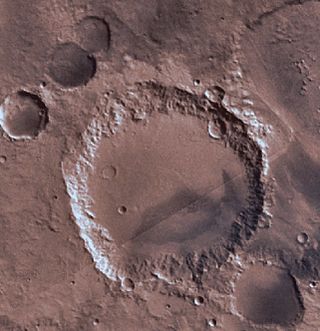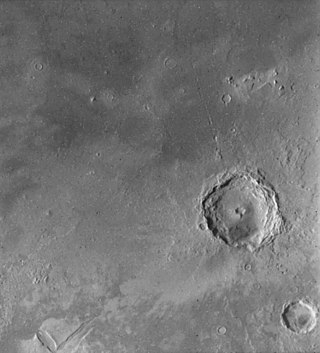Related Research Articles

Areography, also known as the geography of Mars, is a subfield of planetary science that entails the delineation and characterization of regions on Mars. Areography is mainly focused on what is called physical geography on Earth; that is the distribution of physical features across Mars and their cartographic representations. In April 2023, The New York Times reported an updated global map of Mars based on images from the Hope spacecraft. A related, but much more detailed, global Mars map was released by NASA on 16 April 2023.

Beer is a crater lying situated within the Margaritifer Sinus quadrangle (MC-19) region of the planet Mars, named in honor of the German astronomer, Wilhelm Beer. It is located at 14.4°S 351.8°E.

Eugène Michel Antoniadi was a Greek-French astronomer.

Herschel is a 304 kilometer impact crater in the Martian southern hemisphere, at 14.5°S, 130°E, located in the Mare Tyrrhenum region of Mars. The crater is jointly named after the seventeenth/eighteenth century father and son astronomers William Herschel and John Herschel.
2024 McLaughlin, provisional designation 1952 UR, is an asteroid from the inner regions of the asteroid belt, approximately 8 kilometer in diameter. It was discovered 23 October 1952, by the Indiana Asteroid Program at Goethe Link Observatory near Brooklyn, Indiana, and named after American astronomer Dean Benjamin McLaughlin.

James Campbell McLaughlin was a politician from the U.S. state of Michigan.

Mars is the fourth planet and the furthest terrestrial planet from the Sun. The reddish color of its surface is due to finely grained iron(III) oxide dust in the soil, giving it the nickname "the Red Planet". Mars's radius is second smallest among the planets in the Solar System at 3,389.5 km (2,106 mi). The Martian dichotomy is visible on the surface: on average, the terrain on Mars's northern hemisphere is flatter and lower than its southern hemisphere. Mars has a thin atmosphere made primarily of carbon dioxide and two irregularly shaped natural satellites: Phobos and Deimos.

The Mare Boreum quadrangle is one of a series of 30 quadrangle maps of Mars used by the United States Geological Survey (USGS) Astrogeology Research Program. The Mare Boreum quadrangle is also referred to as MC-1. Its name derives from an older name for a feature that is now called Planum Boreum, a large plain surrounding the polar cap.

The Syrtis Major quadrangle is one of a series of 30 quadrangle maps of Mars used by the United States Geological Survey (USGS) Astrogeology Research Program. The Syrtis Major quadrangle is also referred to as MC-13.

The Lunae Palus quadrangle is one of a series of 30 quadrangle maps of Mars used by the United States Geological Survey (USGS) Astrogeology Research Program. The quadrangle is also referred to as MC-10. Lunae Planum and parts of Xanthe Terra and Chryse Planitia are found in the Lunae Palus quadrangle. The Lunae Palus quadrangle contains many ancient river valleys.

The Mare Australe quadrangle is one of a series of 30 quadrangle maps of Mars used by the United States Geological Survey (USGS) Astrogeology Research Program. The Mare Australe quadrangle is also referred to as MC-30. The quadrangle covers all the area of Mars south of 65°, including the South polar ice cap, and its surrounding area. The quadrangle's name derives from an older name for a feature that is now called Planum Australe, a large plain surrounding the polar cap. The Mars polar lander crash landed in this region.

Endeavour is an impact crater located in the Meridiani Planum extraterrestrial plain within the Margaritifer Sinus quadrangle (MC-19) region of the planet Mars. Endeavour is about 22 kilometers (14 mi) in diameter. Using Mars Reconnaissance Orbiter data, phyllosilicate-bearing outcrops have been detected along its rim. These minerals may have formed under wet conditions in a low-acidic environment during the early history of Mars. There are raised rim segments to the north, east, and southwest. The rim has become worn, rounded and degraded, with infilling of plains material in a manner similar to the Victoria crater.

Arandas is a crater in the Mare Acidalium quadrangle of Mars, located 42.77° North and 15.17° West. It is 24.76 km (15.39 mi) in diameter and is named after the town of Arandas in Mexico.

McMurdo is a crater in the Mare Australe quadrangle of Mars, located at 84.4° S and 359.1° W. It is 30.3 km in diameter and was named after McMurdo Station in Antarctica.

Bamberg is an impact crater in the Mare Acidalium quadrangle of Mars. It is named after the town Bamberg in Germany. CTX images and HiRISE images from the Mars Reconnaissance Orbiter have shown that the crater contains gullies. Martian gullies are believed to have formed through rather recent flows of liquid water.

McLaughlin Crater is an old crater in the Oxia Palus quadrangle of Mars, located at 21.9°N 337.63°E. It is 90.92 km (56.50 mi) in diameter and 2.2 km (1.4 mi) deep. The crater was named after Dean B. McLaughlin, an American astronomer (1901-1965). The Mars Reconnaissance Orbiter has found evidence that the water came from beneath the surface between 3.7 billion and 4 billion years ago and remained long enough to make carbonate-related clay minerals found in layers. McLaughlin Crater, one of the deepest craters on Mars, contains Mg-Fe clays and carbonates that probably formed in a groundwater-fed alkaline lake. This type of lake could have had a massive biosphere of microscopic organisms.

Richard Alfred Rossiter was an American astronomer, known for the Rossiter–McLaughlin effect. Rossiter served as director of the Lamont–Hussey Observatory from 1928 until 1952.

Very is a crater on Mars, located south of the planet's equator in the heavily cratered highlands of Terra Sirenum in the Phaethontis quadrangle at 49.2°S and 177.1°W. It measures approximately 114.81 kilometres (71.34 mi) in diameter. The crater was named after American astronomer Frank Washington Very.

Slipher is an impact crater in the Thaumasia quadrangle of Mars, located at 47.3°S latitude and 84.6°W longitude. It measures 127 kilometres (79 mi) in diameter and was named after American astronomers Vesto and Earl Slipher. The naming was approved by IAU's Working Group for Planetary System Nomenclature in 1973.
Laura Elizabeth Hill Mclaughlin was a computer, instructor and researcher of astronomy. As an astronomer of the Detroit Observatory for the University of Michigan, she conducted research work alongside her husband, fellow Detroit Observatory astronomer Dean B. Mclaughlin.
References
- ↑ "'U' Astronomer McLaughlin Dies". Ann Arbor District Library. Retrieved March 6, 2019.
- ↑ "Obituary: Dean B. McLaughlin". Physics Today. 19 (1): 153–154. January 1966. doi:10.1063/1.3047942.
- ↑ "'U' Astronomer McLaughlin Dies | Ann Arbor District Library". aadl.org. Retrieved March 18, 2021.
- ↑ "Martian Crater May Once Have Held Groundwater-Fed Lake". NASA/JPL. Retrieved May 26, 2016.